Intel Atlas Canyon (NUC11ATKPE) and GEEKOM MiniAir 11 UCFF PCs Review: Desktop Jasper Lake Impresses
by Ganesh T S on July 14, 2022 8:00 AM ESTHTPC Credentials
The HTPC-related sections in previous SFF PC reviews covered a range of aspects. Display refresh rate stability (particularly, the ability to drive 23.976 Hz for stutter-free playback of cinema content), OTT streaming efficiency (YouTube and Netflix), and local media playback performance and efficiency evaluation were some of them. While such a detailed study may still make sense for dedicated HTPC reviews, we have decided to pare down the evaluated aspects for system reviews. Workloads were processed on the Intel NUC11ATKPE and the GEEKOM MiniAir 11 for the results in this section.
YouTube Streaming Efficiency
4K video streaming has become ubiquitous enough for its support to be a necessity even for secondary HTPCs. HDR has also become affordable - in fact, one of the key changes for HTPCs in Jasper Lake is the enabling of HDR over HDMI, a feature not available in Gemini Lake-based systems. Keeping these aspects in mind, we have chosen Mystery Box's Peru 8K HDR 60FPS video as our test sample moving forward. On PCs running Windows, it is recommended that HDR streaming videos be viewed using the Microsoft Edge browser after putting the desktop in HDR mode.

YouTube Streaming - Intel NUC11ATKPE (Atlas Canyon)
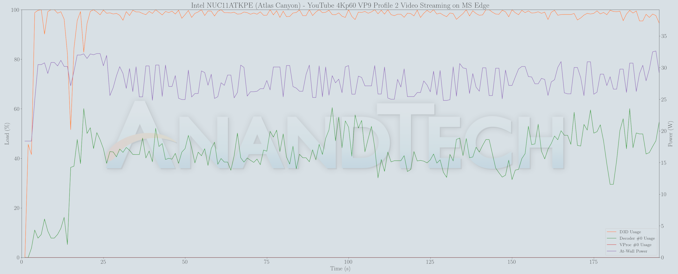
Intel's UHD Graphics for Gen 11 supports hardware decoding for VP9 Profile 2. Taking advantage of this feature, MS Edge automatically fetches the 4Kp60 VP9 Profile 2 encode from the YouTube servers. However, the playback was punctuated by frequent dropped frames on both systems as shown in the statistics segment of the screenshots in this subsection - similar to the behavior observed in the passively-cooled Jasper Lake units.

YouTube Streaming - GEEKOM MiniAir 11
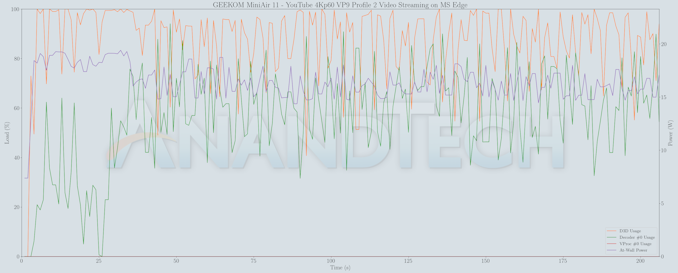
The reason for the dropped frames seems to be excessive D3D usage, which is not observed when playing back similarly encoded media in programs like Kodi or VLC. The fault here lies with MS Edge, but it is not clear how this can be fixed.
The reason for the dropped frames is evident by the spikes in D3D Usage. However, as we shall see further down in this section, this problem doesn't manifest itself in local playback. The culprit here seems to be the MS Edge browser itself, rather than the hardware platform.
Hardware-Accelerated Encoding and Decoding
The transcoding benchmarks in the systems performance section presented results from evaluating the QuickSync encoder within Handbrake's framework. The iGPU in the systems support hardware encode for AVC, JPEG, HEVC (8b and 10b, 4:2:0 and 4:4:4), and VP9 (8b and 10b, 4:2:0 and 4:4:4). The capabilities of the decoder engine are brought out by DXVAChecker. They were the same for both the Intel NUC11ATKPE (Atlas Canyon) and the GEEKOM MiniAir 11.
The decoder engine in Jasper Lake is not the latest and greatest that Intel has to offer. For example, HEVC and VP9 12b support, as well as AV1 support are absent. AV1 is quite new, and the others are required only for professional applications - market segments that are not targeted by Jasper Lake systems.
Local Media Playback
Evaluation of local media playback and video processing is done by playing back files encompassing a range of relevant codecs, containers, resolutions, and frame rates. A note of the efficiency is also made by tracking GPU usage and power consumption of the system at the wall. Users have their own preference for the playback software / decoder / renderer, and our aim is to have numbers representative of commonly encountered scenarios. Considering the target market for Jasper Lake systems, we played back the test streams using the following install-and-forget combinations:
- VLC 3.17.4
- Kodi 19.4
The fourteen test streams (each of 90s duration) were played back from the local disk with an interval of 30 seconds in-between. Various metrics including GPU usage and at-wall power consumption were recorded during the course of this playback. Based on the DXVAChecker report presented previously, the GPU should be able to play back all codecs with hardware acceleration (except for AV1).
All our playback tests were done with the desktop HDR setting turned on. It is possible for certain system configurations to automatically turn on/off the HDR capabilities prior to the playback of a HDR video, but, we didn't take advantage of that in our testing.
VLC and Kodi
VLC is the playback software of choice for the average PC user who doesn't need a ten-foot UI. Its install-and-play simplicity has made it extremely popular. Over the years, the software has gained the ability to take advantage of various hardware acceleration options. Kodi, on the other hand, has a ten-foot UI making it the perfect open-source software for dedicated HTPCs. Support for add-ons make it very extensible and capable of customization. We played back our test files using the default VLC and Kodi configurations, and recorded the following metrics.
| Intel NUC11ATKPE (Atlas Canyon) Video Playback Efficiency - VLC and Kodi | |||
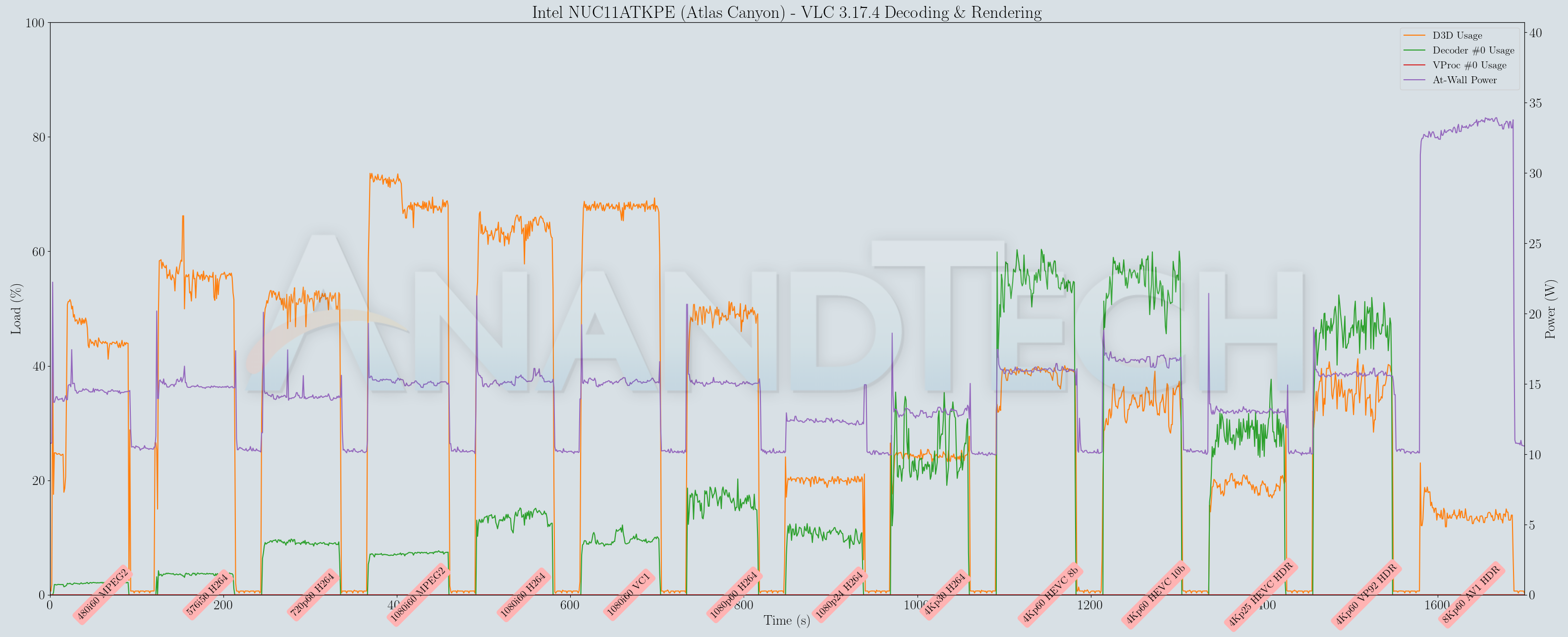
| GEEKOM MiniAir 11 Video Playback Efficiency - VLC and Kodi | |||
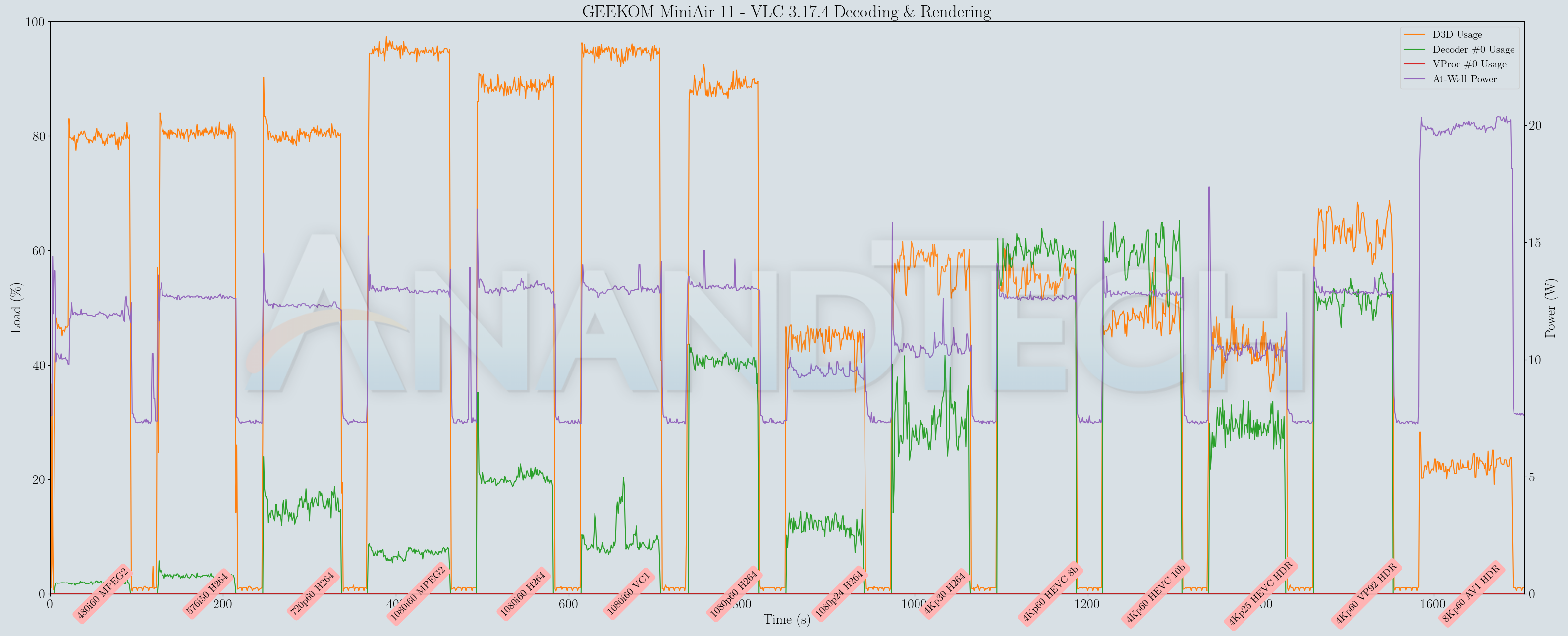
Both players in both systems had great trouble handling the 8Kp60 AV1 clip, due to the absence of hardware acceleration. In addition to consuming lots of power, the playback was just a sequence of frames updated every few seconds. Other than that, all other codecs played without missing a frame, with hardware acceleration activated for low-power playback.
Overall, both systems can be recommended for media playback from the local disk or over the local network. Using web browsers is a hit or miss depending on the codec, resolution, and browser. The presence of hardware acceleration also ensures that the systems are very power-efficient while handling playback workloads.


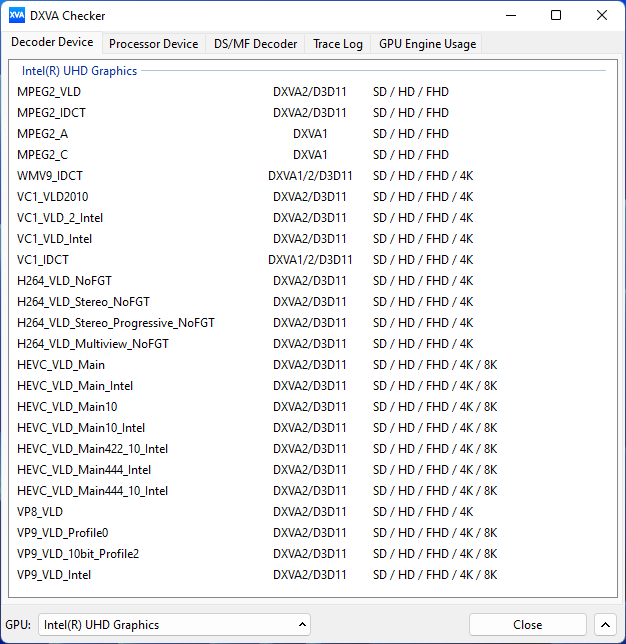








21 Comments
View All Comments
flgt - Thursday, July 14, 2022 - link
Nice article. I don’t like how so much performance is driven by relatively hidden PL1/PL2 settings. Have regular NUC12’s been released yet?AdrianBc - Friday, July 15, 2022 - link
Intel has developed a "Wall Street Canyon" NUC with Alder Lake P, as a replacement for the NUC 11 Pro with Tiger Lake, and which has about the same interfaces but with a much faster CPU.Photos of working prototypes have been leaked, but the launch of the product has been delayed for unknown causes, maybe component shortages. Nevertheless, I do not believed that it will be canceled, but maybe it will be launched later this year.
A very similar NUC-like barebone is already available from ASRock Industrial, as "NUC BOX-12xxP", e.g. "NUC BOX-1260xP", which, compared to Intel, has dual 2.5G Ethernet instead of single 2.5G Ethernet, and 3 DisplayPort (2 on TB) + 1 HDMI instead of 2 DisplayPort (both on TB) + 2 HDMI.
AdrianBc - Friday, July 15, 2022 - link
Sorry, I have pressed "Submit" without rereading and there are a couple of typos.The names for the ASRockInd alternatives are "NUC BOX-1260P", "NUC BOX-1240P", etc.
mode_13h - Friday, July 15, 2022 - link
OMG. I thought "Wall Street Canyon" NUC was a joke. Still funny, though.Sivar - Thursday, July 14, 2022 - link
Some means to compare these values vs. a full desktop CPU would be helpful. In isolation, I can see that the Pentium Silver N6005 is much faster than the J5005, but I have no idea if it is 90% the performance of a desktop CPU, or 60%, or 4%, etc.Perhaps a link to a reasonably comparable desktop CPU review.
mode_13h - Friday, July 15, 2022 - link
> Some means to compare these values vs. a full desktop CPU would be helpful.100% agree. We do have a few data points, however. Using data from https://www.anandtech.com/show/17231/the-intel-cor... we can see:
CineBench R23: Single-threaded
-----------------
NUC11ATKPE: 716
Ryzen 3 5300G: 1338
Ryzen 5 5600G: 1434
i3-12300: 1705
CineBench R23: Mulitthreaded
-----------------
NUC11ATKPE: 2521
Ryzen 3 5300G: 6770
Ryzen 5 5600G: 10601
i3-12300: 8598
Obviously, software rendering is not the kind of workload Tremont is optimized for.
Next, there's Handbrake, but the i3-12300 article used version 1.3.2 and this uses 1.5.1. Without at least a benchmark of the same hardware on both versions, we can't know how much variation is introduced by the new software version.
7-zip might have a similar version difference (earlier article references "1900", while this one uses 21.7), and it's not clear if the test cases are even the same.
And that's basically all the overlap I found. That's less than I thought or hoped for. It's disappointing how much the software versions and format of the results changed, such that I can't even tell whether a given test is using the same workload between the articles.
Hresna - Tuesday, July 19, 2022 - link
Funny, I was just thinking this yesterday. It’s widely impractical I know but perhaps a single chart showing the numbers in context of “modern desktop computing” would add to the general consumption-ability for us casual readers.For so many reviews I end up side-channel trying to look up/remember “ok, what’s my firestrike number again?”.
t.s - Thursday, July 14, 2022 - link
"a 2022 consumer-focused NUC without a single Type-C port is strange to see" LOL. Hello. This is Intel we're talking about, bro.abufrejoval - Thursday, July 14, 2022 - link
Well, you certainly did a much better job than I did with my Atlas Canyon NUC and caught me with quite a few mistakes, too. E.g. I had mis-identified the front panel header hidden under the rubber cap as a USB2 port.I also hadn’t really noticed that PL1/2 had gone to 15/25 in the max performance settings, I guess I was still relying far too much on my Gemini Lake observations.
I’ve never actually observed 25 Watts with HWinfo, the iGPU never goes beyond 5 Watts and the CPU will stay shy of 15 resulting in a 20 Watt total.
For the NUC’s WIFI the most important aspect is that it’s socketed, unlike e.g. on the Tiger Lake NUC11. I had bought a bunch of AX200 cards some time back, because at just €20 they were twice the price of shipping and I replaced the WIFI before I even booted the system.
I got a whole box of below-acceptable WIFI cards, that’s just electronic waste from the factory, because quite a few high-range notebooks also come with such crippling kit.
Likewise, I have another box of RealTek based USB3 2.5 Gbit/s Ethernet adapters, to bring a bit of balance to these systems, which I tend to use with GlusterFS.
I also didn’t have DDR4-2933 SO-DIMMs lying around and was ever so glad the 2x 32GB DDR4-3200 I borrowed from my Tiger Lake NUC11 worked, even if they took quite a bit of time at the initial boot to be configured properly.
DDR4-2400 SO-DIMMS will work just as well and honestly there is very little real difference in performance. The memory bandwidth on Geekbench 4 will change from 16.9/GBs to 17.3GB/s for single core and from 22.2GB/s to 25.6GB/s on multi core. The same DDR4-3200 SO-DIMMs deliver 35.6GB/s single core memory bandwidth with the Tiger Lake’s i7-1165G7 and 39.7GB/s on the multi-core variant, which would almost seem to indicate, that the latest Atom continues to be a single-channel design, like the J5005, N3700 and J1900 predecessors, where the 2nd module never delivered more than a 10% bandwidth increase.
Jasper lake drops to 12.8GB/s with a single module on both the single and the multi core variants of the Geekbench 4 memory bandwidth benchmark and I’m sure the impact on the iGPU would be rather significant, even if I didn’t measure to confirm.
Next I dropped PL1/PL2 to 10/12 Watts (the BIOS won’t allow 10/10) and TAU to 1 second, just to see differentiate properly between the generational improvements of Jasper Lake vs. Goldmont Plus and the additional TDP budget: it barely made a difference on Geekbench 5, whilst HWinfo did confirm that the lower TDP limits were indeed observed.
It takes Prime95 to confirm, that the TDP budget difference has an impact on the clocks, Geekbench is just too light a workload. And in combination with Furmark, you can also nicely observe that the iGPU TDP share is fixed at 5 Watts, while the CPU core have to manage with what’s left at 25 or 15 Watts after TAU.
I do believe the Atlas Canyon NUC11 is a rather good deal for the €200 price, if you can get one. I’ve found a niche dealer here in Germany (minipc.de), that still has dozens in stock but that seems a rare exception. There are still some N6005 based firewall appliances available from China, even fully passive but at closer to €500 before taxes.
Ian started to ruminate on how he’d be able to measure the generational improvements of Grace Mont over Jasper Lake by using Lasso to control CPU core assignments on an Alder Lake base. Too bad he then never got around testing that, because it could have helped to gauge a hypothetical all-E-core chip.
Jasper Lake does rather well against say a Broadwell based Xeon D-1541 at 2.7GHz so it’s easy to see why they are not to keen on seeing these low-end devices compete in the mini-server market. Elkhart Lake Atoms variants which support inline ECC would certainly create an issue, if they sold for a similar price than Jasper Lake (I heavily suspect they are the same silicon). But a SuperMicro mainboard with zero other distinguishing features (e.g. only Gbit Ethernet) is listed at €800, way beyond what I’d want to pay for ECC alone.
mode_13h - Friday, July 15, 2022 - link
> DDR4-2400 SO-DIMMS will work just as well and honestly there is very little real difference in> performance. The memory bandwidth on Geekbench 4 will change from 16.9/GBs to 17.3GB/s
> for single core and from 22.2GB/s to 25.6GB/s on multi core.
> ... the latest Atom continues to be a single-channel design
> Jasper lake drops to 12.8GB/s with a single module on both the single and the multi core
That's a 35% benefit for single-core and a 100% boost for multi-core. Whatever is going on there, I think it's simplistic to say the SoC is simply designed for single-channel.
It's weird that they hampered it, because they're just leaving performance on the table. I wonder if maybe the memory controller is more optimized for LPDDR4 and the regular DDR4 performance is more of an afterthought.
BTW, thanks for your TDP testing, also.